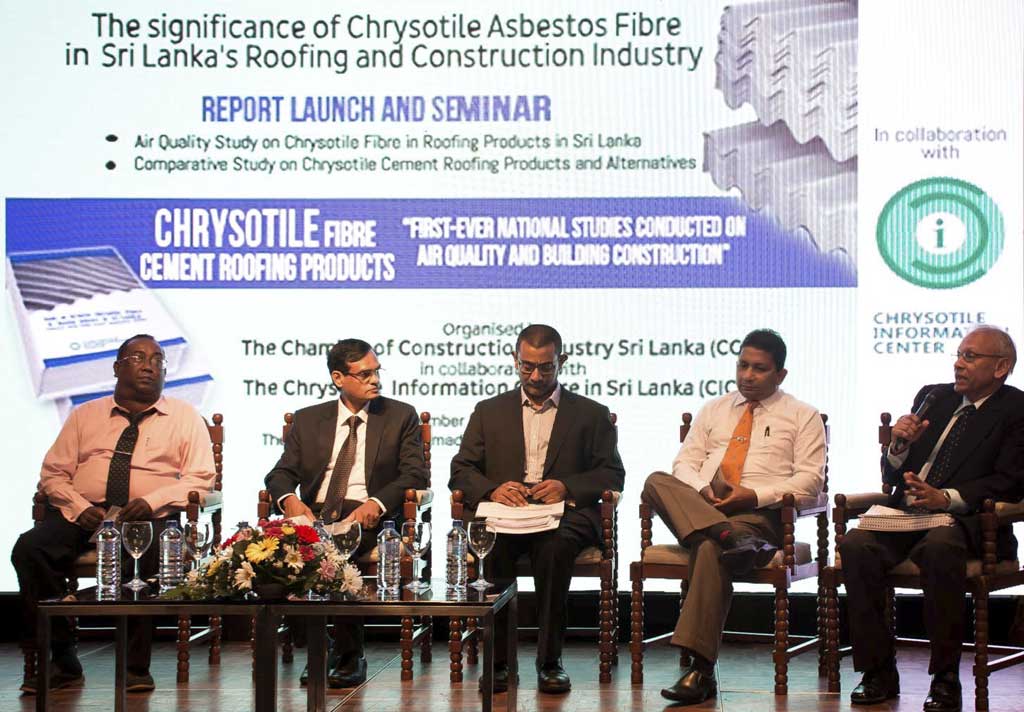
16th November 2017, Colombo – The Chamber of Construction Industry Sri Lanka (CCI) and the Chrysotile Information Centre of Sri Lanka (CIC) are pleased to share the findings of two in-depth studies conducted by the National Building Research Organization (NBRO) and the University of Moratuwa on Chrysotile roofing products. Of note, these are the first-ever such studies to be conducted in Sri Lanka.
Specifically, reports titled ‘Air-Pollution from Chrysotile Fibre in Roofing Products in Sri Lanka’ and ‘A Comparison of Substitutes for Chrysotile Fibre Cement Roofing Sheets’ were shared today with public at a conference held recently at the Hotel Ramada, Colombo.
The first study, carried out by the NBRO, reviewed conditions in both the working (ambient) and general environment. The NBRO carried out the study focusing on chrysotile fiber exposure in three main areas – manufacturing sites, construction sites and demolition sites and houses – where Chrysotile cement roofing sheets are used.
According to H.D.S. Premasiri, Senior Scientist at Environmental Studies & Service Division, NBRO, “All the exposure levels of chrysotile fibers in all three studies are much below internationally-recognized safety thresholds limit [OSHA (Occupational Safety and Health Administration) Standard of Permissible Exposure Limit (PEL)] which is 0.1 Fiber per cubic centimeter in all three studies”.
Mr. Sunil Amarawansa, Director of the Chrysotile Information Centre added that “In Sri Lanka there are four manufacturers engaged in the manufacture of Chrysotile cement fiber roofing sheets and all the factories have adopted the “Safe Use of Chrysotile Fibre” practice, minimizing the risk of Chrysotile fiber to become air borne and prevent exposure to workers.”
The second study, conducted by the University of Moratuwa involved a comprehensive, comparative analysis of Chrysotile fibre cement roofing sheets and the proposed alternative fibre roofing sheets. The analysis reviewed comparative engineering properties, usage and technical aspects by conducting technical examination and standard testing to determine the strength and durability.
The study was conducted under the supervision of Professor Asoka Perera, Professor of Civil Engineering at the University, an recognized expert on cement and concrete, and an authority on the subject of developing alternative materials to Chrysotile cement roofing.
Professor Asoka stated, “The purpose of this study was to understand the quality differences of alternative roofing materials versus chrysotile cement roof tiles. The results revealed that non-asbestos fiber cement roofing are nearly two times weaker than chrysotile asbestos sheets, they must be replace frequently, and the total life cycle cost is comparatively higher than Chrysotile Cement roofing sheets.” Furthermore, the study suggests thatproposed non-asbestos roofing sheets cannot replace current chrysotile-cement roof tiles because non-asbestos sheets are far below the required qualityincluding durability and strength that are vital for the safety of the consumers.
Since 1955, Sri Lanka has used locally produced chrysotile containing roofing material for home and commercial use. Both international and domestic studies have shown that there is no clear evidence or data on health risks of chrysotile to workers or consumers.
On the critical issue of public health risk, to date not a single specific study that shows the disease burdens caused by chrysotile in Sri Lanka has been conducted. Of note, Professor Ravindra Fernando, Chairman, National Dangerous Drugs Control Board, Faculty of Medicine, University of Colombo said “The latest scientific evidence published internationally strongly supports that Chrysotile is significantly less hazardous than the amphibole forms of asbestos (e.g. crocidolite and amosite) which are NOT imported to Sri Lanka and when properly controlled and used, chrysotile asbestos in its modern day high-density applications does not present risks of any significance to public and/or workers’ health. Therefore, Sri Lanka should NOT ban the use of chrysotile asbestos.”
These two research studies have shown that chrysotile fibre cement presents no airborne fiber risk to workers or consumers and that the products are superor to any substitutes currently on the market. In addition, chrysotile asbestos roof sheets are the preferred choice of roofing materials, especially amongst Sri Lanka’s low and mid-income populations. A potential ban on Chrysotile poses adverse impacts on the national economy, even affecting householders’ affordability and quality of living conditions. Therefore, through the release and dissemination of this research, the organizer aim to provide valuable references and guidance to key decision makers, authorities and stakeholders – towards making favourable decisions to support the country’s economy, and national health, while maintaining a positive environment for international trade relations.


